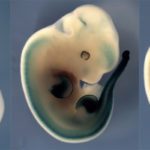Link to Pubmed [PMID] – 25640223
Dev. Cell 2015 Feb;32(3):265-77
Hox transcription factors (TFs) are essential for vertebrate development, but how these evolutionary conserved proteins function in vivo remains unclear. Because Hox proteins have notoriously low binding specificity, they are believed to bind with cofactors, mainly homeodomain TFs Pbx and Meis, to select their specific targets. We mapped binding of Meis, Pbx, and Hoxa2 in the branchial arches, a series of segments in the developing vertebrate head. Meis occupancy is largely similar in Hox-positive and -negative arches. Hoxa2, which specifies second arch (IIBA) identity, recognizes a subset of Meis prebound sites that contain Hox motifs. Importantly, at these sites Meis binding is strongly increased. This enhanced Meis binding coincides with active enhancers, which are linked to genes highly expressed in the IIBA and regulated by Hoxa2. These findings show that Hoxa2 operates as a tissue-specific cofactor, enhancing Meis binding to specific sites that provide the IIBA with its anatomical identity.

